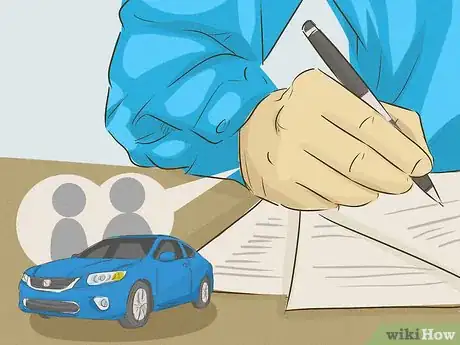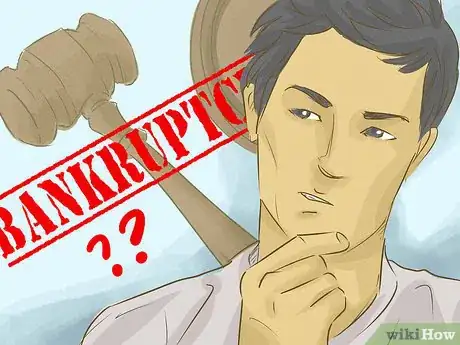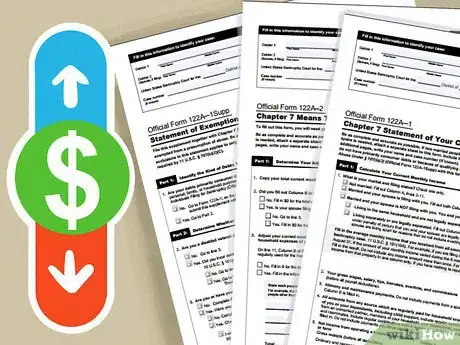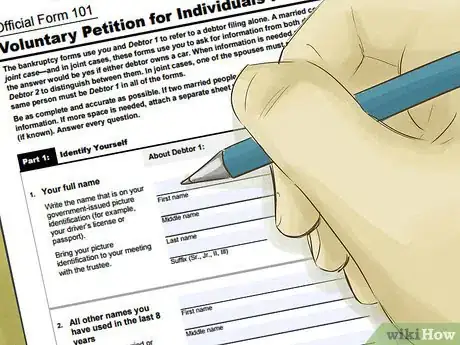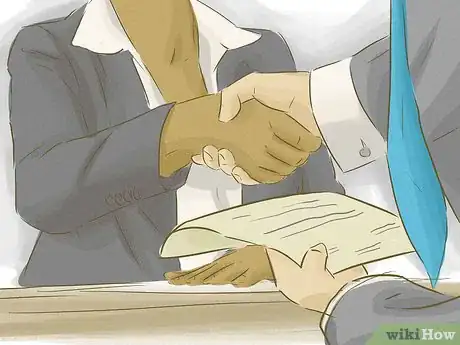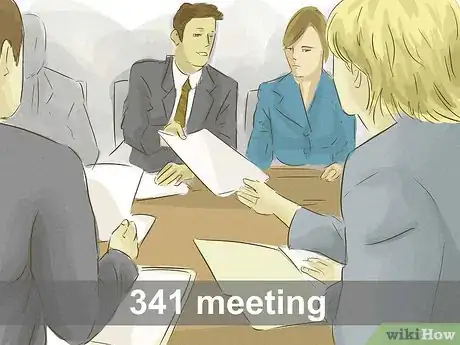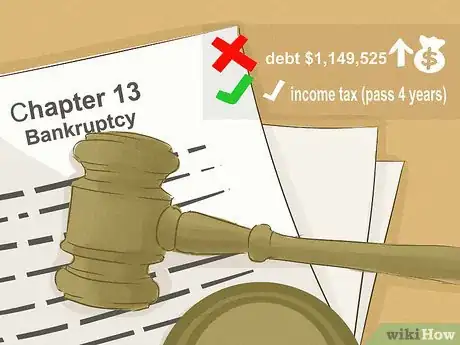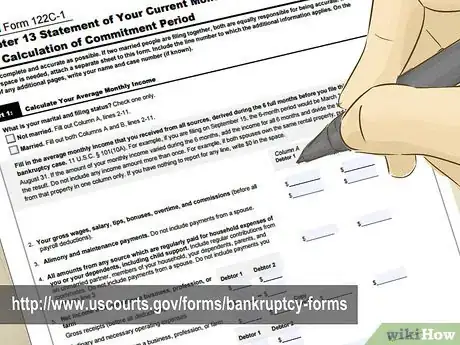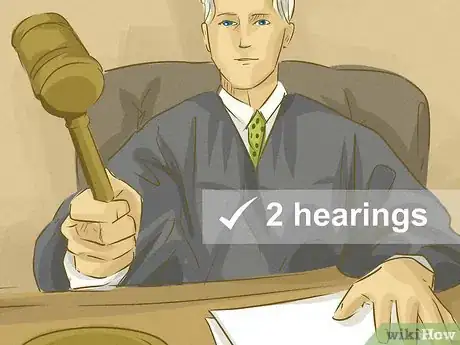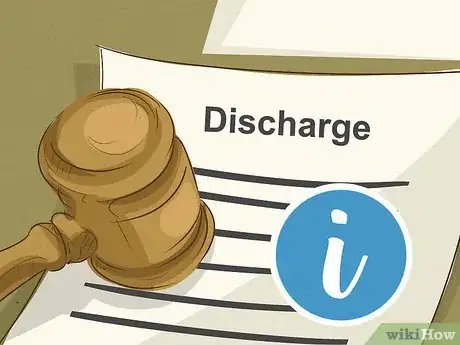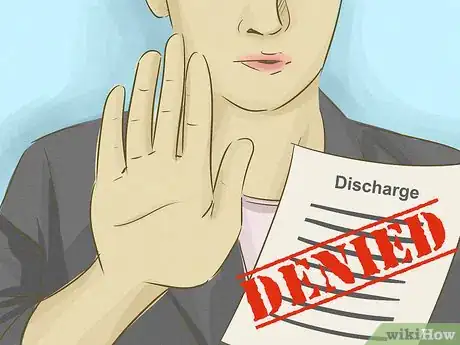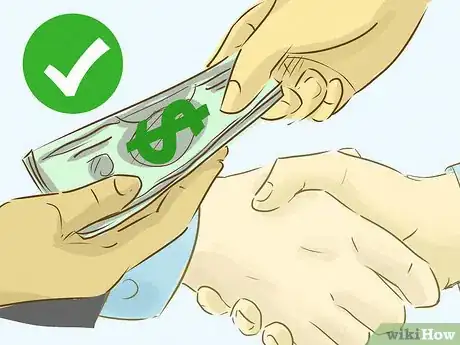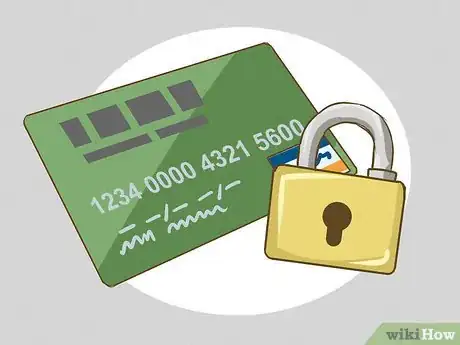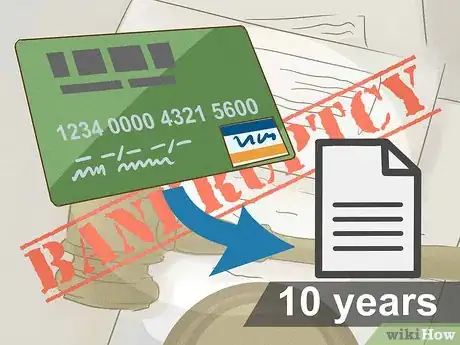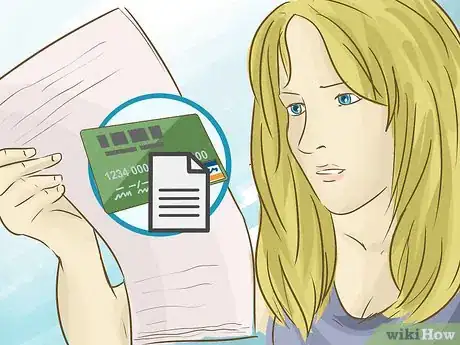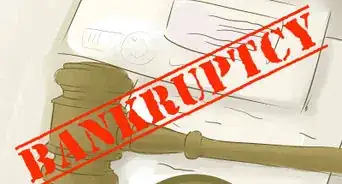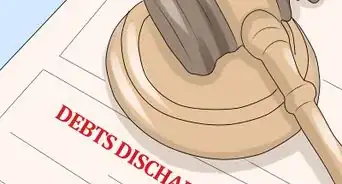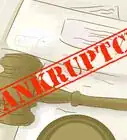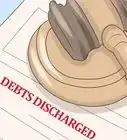This article was co-authored by Clinton M. Sandvick, JD, PhD. Clinton M. Sandvick worked as a civil litigator in California for over 7 years. He received his JD from the University of Wisconsin-Madison in 1998 and his PhD in American History from the University of Oregon in 2013.
There are 26 references cited in this article, which can be found at the bottom of the page.
wikiHow marks an article as reader-approved once it receives enough positive feedback. In this case, 94% of readers who voted found the article helpful, earning it our reader-approved status.
This article has been viewed 1,288,383 times.
Bankruptcy laws are a series of federal laws enacted to allow people to be relieved from their debts and start over with a clean slate. The laws changed in 2005, making the road to a fresh start more complicated, so it is important to completely understand the benefits and drawbacks before you decide to declare bankruptcy. Understand how to know when you should file bankruptcy, the different types of bankruptcy, and the procedure for filing.
Steps
Deciding to File for Bankruptcy
-
1Consider other options. Bankruptcy should only be used as a last resort. Before filing, try other options available to you to pay off your debts. Contact your creditors and try to negotiate for a loan settlement or a repayment plan with lower payments. Alternately, you can try a short sale of your assets to cover your debt, assuming you are not underwater on your loan. Try consulting with a debt management agency before deciding to file for bankruptcy.
-
2Analyze your debt. Certain kinds of debt cannot be discharged, or erased, even if you declare bankruptcy. Categorize all of your debt and calculate how much falls into categories that cannot be discharged. If the majority of your debt cannot be erased, then bankruptcy may not the right option for you. Note that each state has specific provisions for those assets which are exempt from bankruptcy. Be sure to check state law. The following kinds of debt cannot be discharged in a bankruptcy:[1]
- Alimony
- Child Support
- Debts that arise after bankruptcy is filed
- Some debts incurred in the six months prior to filing bankruptcy
- Loans obtained fraudulently
- Debts from personal injury while driving intoxicated
- Debts from willful and malicious injuries to person or property
- Some student loans
- Some taxes
- Secured loans, as lenders can foreclose on their capital
Advertisement -
3Know which assets are exempt from seizure in bankruptcy proceedings. While bankruptcy proceedings will seek to seize and sell off your valuable assets to repay creditors, there are some assets that are protected under state law. The exempted assets will depend on the type of bankruptcy you are filing for and your state's laws. Assets may be completely protected or protected up to a certain value. For example, there might be at automobile exemption of $5,000, meaning that you could keep a $4,000 car but not a $20,000 one.
- Common protected assets are cars, wedding rings, and your home.
- Some states may offer "wild card" exemptions that allow you to keep any other valuable assets up to a certain amount.
- Chapter 13 bankruptcy allows you to keep all of your assets, but you can reduce your liability to creditors by selling of assets of significant value.[2]
-
4Understand that bankruptcy does not erase debt for cosigners. A cosigner agrees to pay your debt in the event that you cannot pay. For example, a parent may have cosigned an auto loan for you when you graduated from college because you had little or no credit. However, if you declare bankruptcy, a cosigner on your loan is still be legally obligated to repay your debt. For example, your parent will still have to repay all or part of that car loan, even if you declare bankruptcy.[3]
-
5Learn about the different kinds of bankruptcy. Bankruptcy in the United States is handled in federal court under the rules of the U.S. Bankruptcy Code. The U.S. Bankruptcy code identifies several different kinds of bankruptcy. These are usually referred to by their chapter in the U.S. Bankruptcy code.[4]
- Individuals and businesses may file for Chapter 7. Property may be liquidated to pay off creditors. Secured debt may be eliminated, or you have the option of allowing the property to be repossessed or paying the creditor a lump sum equal to the current value of the property. Your income must be below a certain level to qualify for Chapter 7.[5]
- Chapter 13 is also known as “wage earner” bankruptcy. Under Chapter 13, if you have a reliable source of income, you can propose a repayment plan to your creditors that pays them back over the next three to five years. Your debts must be below $1,149,525 in secured debt and $383,175 in unsecured debt.[6] Note that the amount received by the creditors is established by your income after bankruptcy, not the amount of debt owed.
- Municipalities, such as cities, towns, villages, taxing districts, municipal utilities, and school districts can reorganize under Chapter 9.[7]
- Businesses can reorganize under Chapter 11 or liquidate under Chapter 7.[8]
- Chapter 12 is similar to Chapter 13. It is reserved for businesses for which 80% or more of debt is from the operation of a family farm or fishery.[9]
-
6Understand the Consequences of Bankruptcy. Learn about the kinds of debt that can be erased and what debts will not be forgiven. Recognize the impact on cosigners to your loans. Decide if you can live with the negative impact bankruptcy has on your credit. Evaluate whether or not you even qualify for bankruptcy.[10]
- The impact bankruptcy has on your credit is largely determined by how good your credit is to begin with. If your credit score is high, it will probably take a huge hit and drop significantly. If your credit is already pretty bad, bankruptcy might not lower your score by very much.[11]
- The more accounts associated with the filing, the bigger the impact on your credit score.[12]
- If you file for Chapter 7 or 11, it will remain on your credit report for up to 10 years. If you file for Chapter 13, it may stay on your report for up to seven years.
- A Chapter 11 bankruptcy will stay on the business's credit report, not the individual owner's, unless they file a personal bankruptcy.
Filing for Chapter 7
-
1Consider hiring a bankruptcy attorney. Hiring an attorney is not required, but it is recommended. Filing for bankruptcy is a very complicated process and is rarely successful without the help of an attorney. Free legal services are available for those who cannot afford an attorney.[13] For help finding an attorney, contact the American Bar Association[14] or the Legal Services Corporation.[15] .
- Filing without an attorney is called filing pro se. If you do decide to file pro se, the court may allow non-attorney preparers to help you. They can only help you with paperwork. They cannot answer legal questions or provide legal advice. Since they don’t represent you, they cannot sign anything on your behalf or receive payment for court fees.[16]
- The United States has 90 bankruptcy districts, each with one bankruptcy court. Every state has at least one or more districts.[17]
-
2Find out whether or not you qualify. To file for Chapter 7 bankruptcy, your income must be below a certain level. If you have any income left over after paying your monthly expenses, then you must file for Chapter 13 and make arrangements to repay your creditors. Take the “means test” to find out if you qualify for Chapter 7. Complete a series of three forms to take the means test.
- You may not have to fill out all of the forms. Your answers on the first form determine whether or not you have to fill out the others.[18]
- Download form 22A-1 from the U.S. Court’s website. The form takes you through the steps of calculating your income and comparing it to the median income in your state for the same household size. If your income is below the state median, then you qualify for Chapter 7. If not, you proceed to form 22A-2.
- Download form 22A-2 from the U.S. Court’s website. The form takes you through further analysis of your income to determine if you qualify for Chapter 7.[19]
- Fill out form 22A-1Supp to determine if you are exempt from the means test because most of your debts are from business expenses or you have recent military service.[20]
-
3Fill out the bankruptcy forms. The bankruptcy forms list all of your property, debt, income and expenses for the court. You must complete a large packet of forms. These forms include the bankruptcy petition, a series of schedules and various other forms. Download the forms from the U.S Court’s website.
- All debts need to be listed to be discharged; failure to list a debt may mean it continues after the bankruptcy.
-
4File the bankruptcy forms. Filing the forms officially begins your case. If you are using an attorney, they will file the forms for you. If you are representing yourself, then you can take them to the bankruptcy court yourself.[21]
-
5Receive a bankruptcy trustee. The court will assign you a trustee when you file the forms. The trustee works on behalf of your creditors. This person is responsible for verifying the information in your bankruptcy documents. The trustee also looks at the property you own and determines how much of it you can keep. Each state has rules that govern what property is exempt from liquidation in a Chapter 7 bankruptcy. The trustee determines this for your case and liquidates any non-exempt property.[22]
- A bankruptcy judge presides over the bankruptcy court. The bankruptcy judge rules on matters such as eligibility and discharges. A debtor rarely has to appear in court before the bankruptcy judge. Much of the process is administrative and is carried out by the trustee away from the courthouse.
-
6Get credit counseling. Any individual filing for bankruptcy is required to receive credit counseling and debtor education. Credit counseling is done before filing for bankruptcy. Debtor education occurs after bankruptcy. Certificates of completion must be presented to the court before debts can be discharged. Organizations providing these services must by approved the U.S. Trustee Program.[23]
-
7Attend the 341 Meeting. You will have to attend a formal meeting of creditors, which usually happens at the offices of your trustee. This meeting with creditors is known as the 341 meeting, referring to section 341 of the Bankruptcy code. This requires debtors to face creditors so they can answer questions about their debts and property. The meeting will occur approximately one month after you file. [26] During the meeting, the trustee asks you questions about your debt and why you are filing for bankruptcy. Arrangements for selling your non-exempt property are made. Also, arrangements are made for property pledged as collateral in secured loans.[27]
Filing for Chapter 13
-
1Evaluate your eligibility for Chapter 13 bankruptcy. Businesses cannot file for Chapter 13, even if you are a sole proprietor. You must have a certain amount of disposable income. Your debts cannot be too high. You do not qualify for Chapter 13 bankruptcy if your secured debts exceed $1,149,525. Also you must be current on your income taxes. You must prove that you filed your federal and state income taxes for the past four tax years.[28]
-
2Fill out the bankruptcy forms. List all of your financial data. Indicate your income. Value your property. Enter your repayment plan. The forms for Chapter 13 are the same as the forms from Chapter 7. Download the forms from the U.S Court’s website.
-
3File your bankruptcy forms with the court. A trustee will be appointed to your case by the court. Realize, however, that the trustee represents your creditors, not you. This person’s job is to verify your information, look for fraud and administer the bankruptcy procedures. If you feel you need representation, you should hire an attorney. However, you are not required to have one.[29]
-
4Attend two hearings. Within approximately one month of filing for bankruptcy, you will attend a meeting with your creditors. The trustee will arrange this meeting. Here you will answer questions about your debt and negotiate the terms of your repayment plan. Shortly thereafter, you will attend a confirmation hearing with a bankruptcy judge who will confirm your repayment plan.[30] .
Getting a Discharge
-
1Learn what a discharge means. If you are awarded a bankruptcy discharge, you are no longer legally required to repay some kinds of debts. This is a permanent order. Creditors can take no further action against you to collect the debt. They cannot communicate with you about the debt. They can take no legal action against you.[31]
- Unless there are any objections to the discharge, it is usually granted automatically. Creditors, debtors and their attorneys all receive copies of the order of discharge.
-
2Know when you can expect the discharge to occur. The amount of time it takes to get a discharge varies depending on the type of bankruptcy for which you file. The court can deny a discharge if the petitioner does not complete the required credit counseling and debt education courses. Exemptions from this requirement can be granted in some cases if the debtor is disabled or on active military duty.[32]
- In a Chapter 7 case, the discharge can happen within 60 days of the first 341 meeting, which is usually approximately four months from the date the debtor files for bankruptcy. It may take longer if a creditor files a complaint objecting to the discharge or a motion to dismiss the case.
- In Chapter 13 cases, the court grants a discharge after the debtor completes all agreed-upon payments. Since these payment plans last three to five years, it may take several years for the discharge to be granted.
-
3Prepare for debts that cannot be discharged. The kinds of debts that can be discharged vary depending on the kind of bankruptcy filed. Congress determines the kinds of debts that cannot be discharged. These decisions are based on public policy. Debtors must still repay those debts that cannot be discharged.[33]
- The categories of debt that cannot be discharged include some taxes, spousal or child support, debts for personal injury, student loans, and debts owed for driving under the influence.
- Under Chapter 13, some debts can be discharged that would not be dischargeable under other chapters. These include some taxes, some personal injury debts, and debts from property settlements during a divorce. Petitioners can also file a hardship discharge if they are unable to complete the planned payments due to circumstances beyond their control.
-
4Realize that a discharge is not guaranteed. Creditors can object to and block a discharge by filing a complaint in the bankruptcy court. This is known as an adversary proceeding. The court can deny a discharge if you delay or hinder the proceedings. For example, you will not receive a discharge if you do not supply the proper documents, fail to complete the required educational courses, willfully conceal or destroy records or property or perjure yourself.[34]
- A discharge can be revoked if it is determined that it was obtained fraudulently. This typically occurs within one year of the discharge.
-
5Consider repaying some discharged debts. You may choose to repay some debts that have been discharged. Discharged debts cannot be legally enforced, but you can voluntarily repay them. For example, if you owe money to a family member, you may choose to repay that debt. Also, you may want to repay a debt to someone whose opinion is important to you. An example would be debts for medical treatment from a family doctor.[35]
-
6Keep copies of the discharge court papers. Keep all discharge court papers and decisions for your records. These will help you prove the debts have been discharged in the event creditors attempt to collect old debts. Creditors may claim after the fact that debts were discharged dishonestly, so having the papers to prove the court's decision can be useful.
Recovering from Bankruptcy
-
1Create a budget. Develop a realistic spending plan. Pay all of your bills on time. Stick to your budget at all costs. Avoid accumulating any more debt. Save to establish an emergency fund to help you deal with unexpected expenses.[36]
- Set up automatic payments to help you pay your bills on time.
-
2Adopt a simpler life style. Reduce your living expenses if possible. Pay less for groceries and housing. Purchase items with cash only. If you filed for Chapter 13, then you are living within a court-appointed budget while you work to repay debts. You will not be able to get a credit card or an auto loan without the court’s permission.[37]
-
3Get a secured credit card. Set up a secured credit card by depositing a given amount of money into a bank account. This sets your spending limit. Charge small amounts to this account each month. Pay the bill on time and as agreed. Secured credit cards help rebuild credit. Some cards may reward responsible payments by increasing the spending limit without requiring an additional deposit.[38]
-
4Understand how bankruptcy will affect your credit. It is possible to successfully bounce back from bankruptcy more quickly than you would think. You may still qualify for an FHA home loan. You will still receive credit card offers. You will still be able to get other loans, such as auto loans, at a reasonable rate. Bankruptcy does remain on your credit report for up to 10 years. However, your credit score can recover quickly if you make all of your payments on time.[39]
-
5Review your credit report. You can receive one free credit report each year. Review your credit report and check for errors. Make sure debts you no longer owe are not listed. Look for incorrect balances. Check for debts that are not yours. If you find an error, file a claim with the credit reporting agency.[40]
References
- ↑ https://www.debt.org/bankruptcy/
- ↑ http://www.nolo.com/legal-encyclopedia/bankruptcy-exemptions-overview.html
- ↑ https://www.debt.org/bankruptcy/
- ↑ http://www.uscourts.gov/services-forms/bankruptcy
- ↑ http://www.nolo.com/legal-encyclopedia/chapter-7-13-bankruptcy-basics-29829.html
- ↑ http://www.nolo.com/legal-encyclopedia/chapter-7-13-bankruptcy-basics-29829.html
- ↑ http://www.uscourts.gov/services-forms/bankruptcy
- ↑ http://www.uscourts.gov/services-forms/bankruptcy
- ↑ http://www.nolo.com/legal-encyclopedia/chapter-7-13-bankruptcy-basics-29829.html
- ↑ http://www.nolo.com/legal-encyclopedia/considering-bankruptcy.html
- ↑ http://www.myfico.com/crediteducation/questions/bankruptcy-fico-score.aspx
- ↑ http://www.myfico.com/crediteducation/questions/bankruptcy-fico-score.aspx
- ↑ https://www.debt.org/bankruptcy/
- ↑ https://www.americanbar.org/groups/legal_services/flh-home/
- ↑ http://www.lsc.gov/
- ↑ http://www.uscourts.gov/services-forms/bankruptcy/filing-without-attorney
- ↑ http://www.uscourts.gov/services-forms/bankruptcy/bankruptcy-basics/process-bankruptcy-basics
- ↑ http://www.nolo.com/legal-encyclopedia/completing-the-means-test-form-22a-chapter-7-bankruptcy.html
- ↑ http://www.nolo.com/legal-encyclopedia/completing-the-chapter-7-bankruptcy-means-test-form-22a-2-doing-the-calculations.html
- ↑ http://www.nolo.com/legal-encyclopedia/completing-the-chapter-7-bankruptcy-means-test-form-22a-supplement.html
- ↑ http://www.nolo.com/legal-encyclopedia/chapter-7-bankruptcy-29454.html
- ↑ http://www.nolo.com/legal-encyclopedia/bankruptcy-trustee-chapter-7.html
- ↑ http://www.uscourts.gov/services-forms/bankruptcy/credit-counseling-and-debtor-education-courses
- ↑ http://www.justice.gov/ust/list-credit-counseling-agencies-approved-pursuant-11-usc-111
- ↑ http://www.justice.gov/ust/list-approved-providers-personal-financial-management-instructional-courses-debtor-education
- ↑ http://www.uscourts.gov/services-forms/bankruptcy/bankruptcy-basics/process-bankruptcy-basics
- ↑ http://www.nolo.com/legal-encyclopedia/meeting-creditors-chapter-7-bankruptcy.html
- ↑ http://www.nolo.com/legal-encyclopedia/chapter-13-bankruptcy-eligibility-29738.html
- ↑ http://www.nolo.com/legal-encyclopedia/how-file-chapter-13-bankruptcy-29457.html
- ↑ http://www.nolo.com/legal-encyclopedia/how-file-chapter-13-bankruptcy-29457.html
- ↑ http://www.uscourts.gov/services-forms/bankruptcy/bankruptcy-basics/discharge-bankruptcy-bankruptcy-basics
- ↑ http://www.uscourts.gov/services-forms/bankruptcy/bankruptcy-basics/discharge-bankruptcy-bankruptcy-basics
- ↑ http://www.uscourts.gov/services-forms/bankruptcy/bankruptcy-basics/discharge-bankruptcy-bankruptcy-basics
- ↑ http://www.uscourts.gov/services-forms/bankruptcy/bankruptcy-basics/discharge-bankruptcy-bankruptcy-basics
- ↑ http://www.uscourts.gov/services-forms/bankruptcy/bankruptcy-basics/discharge-bankruptcy-bankruptcy-basics
- ↑ http://www.dailyfinance.com/2011/06/03/life-after-bankruptcy-5-steps-to-rebuilding-your-credit-financ/
- ↑ http://www.bankrate.com/finance/debt/life-after-bankruptcy-1.aspx
- ↑ http://www.dailyfinance.com/2011/06/03/life-after-bankruptcy-5-steps-to-rebuilding-your-credit-financ/
- ↑ http://www.dailyfinance.com/2011/06/03/life-after-bankruptcy-5-steps-to-rebuilding-your-credit-financ/
- ↑ http://www.nolo.com/legal-encyclopedia/tips-repair-your-credit-after-bankruptcy.html
About This Article
To file bankruptcy in the United States, start by determining which kind of bankruptcy you should file for. If you're an individual or business, you can file for Chapter 7 bankruptcy if your income is lower than your monthly expenses. If you're an individual and your income is greater than your monthly expenses, you can file for Chapter 13 bankruptcy as long as your debts don't exceed the limit. Once you know what bankruptcy you want to file for, you'll need to fill out the necessary paperwork and file it with a court. To learn more about the bankruptcy application process, keep reading.



